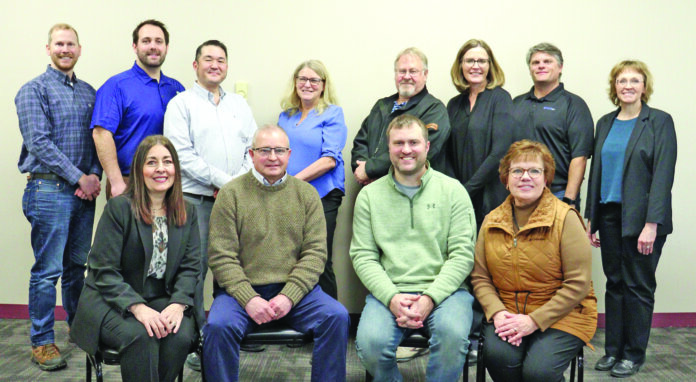
by David Hill
Editor
The effort to retain and increase high-quality childcare in Thief River Falls, and an initiative to enhance resident recruitment and retention received most of the focus of a meeting of Advance Thief River.
Advance Thief River, an economic development driver for the community of Thief River Falls, held its annual meeting on Tuesday, Feb. 5, at the American Legion in Thief River Falls.
The U.S. Census reported that Thief River Falls expanded its population by 300 residents, and Pennington County expanded its population by 600 residents … over a 20-year period. That’s roughly 15 new residents per year for the community. Michelle Landsverk, executive director of Advance Thief River noted that this is what is being reported when they know businesses are recruiting and hiring hundreds of new employees every year. One of the conclusions to be drawn from this is that people are coming to the community, but not staying.
One of the initiatives of Advance Thief River Falls is called Join Us Thief River and it focuses on resident recruitment and retention. That effort includes providing welcoming events for new residents and community navigator services. There are roughly 24 navigators in the community, many of whom are members of Advance Thief River and are local business leaders. Landsverk talked about first steps at welcoming new residents. These events, she said, help new visitors to the community connect with area residents, and have been very successful.
During the past year, Advance Thief River also took steps to support small business. In the fall of 2023, it received a two-year grant for $100,000 to help small businesses. Landsverk said they have identified and served 45 unique clients, recorded 558 hours of direct service and accessed $461,990 in capital.
But the chief topic of discussion Tuesday was the efforts undertaken to improve the childcare picture in the community.
Landsverk said that in 2022, the organization approved three goals – raise $100,000 to reverse the decline in childcare provider numbers and strengthen the childcare ecosystem, support Discovery Place through its expansion to improve success and community impact, and grow the early education support group of childcare providers in the community.
To date, the organization has raised $42,750 of the $100,000 goal, and issued 10 grants in January to help retain 122 licensed childcare spots.
Discovery Place is leasing a vacant section of Valley Assisted Living on the south end of town and is in the process of renovating that space for its needs.
Plans call for the Discovery Place center at Valley Assisted Living to open on June 1. It will have 156 daycare slots. Currently, Discovery Place has 91. That represents an increase of 65 slots. Discovery Place plans to continue to own the location at Nora Street, do a reset and potentially offer space to other daycare providers.
First Children’s Finance
Jessica Beyer and Michele Hutchinson of First Children’s Finance, were guest speakers at the annual meeting.
Founded in 1991, First Children’s Finance, a non-profit organization, addresses the business and finance needs of child care in three different ways: building the financial sustainability of child care entrepreneurs, partnering with communities to preserve and grow their child care supply, and influencing state and federal systems to provide supports and investments needed to sustain child care businesses.
Beyer talked about the importance for community members and childcare providers in understanding the costs childcare providers experience. Data shows that the average annual cost of infant care is $16,087 or $1,341 per month. That’s 21.2% of the median family’s income in Minnesota. It costs 30.8% more than average rent. Data also shows the average annual cost of preschool care is $12,252 or $1,021 per month. The median-income family with an infant and a 4-year-old would pay 37.4% of their income on child care.
This points out the disconnect. Families can’t afford child care, and the child care business already has narrow profit margins.
Currently, the average annual cost of providing a family childcare is $37,774. Occupancy costs on average $9,576, program expenses $14,382, and administration expenses $7,211.
In rural communities, net revenues come in around $28,789. That works out to be about $8.65 per hour, which clearly indicates they aren’t in it for the money. In fact, it’s not a living wage.
Beyer noted that a typical rural childcare provider serving roughly 100 children can expect to have a budget of $957,180. Sixty-eight percent of its expenses will be related to personnel costs, and 14% to occupation costs. Wages in rural child care centers range from $23.38 per hour for directors to $13.54 per hour for teacher aides. A lead teacher is paid about $17.20 per hour.
Beyer also talked about the analysis they undertake to understand the impact on families, as well as businesses. Fifty-five percent of families surveyed said that the challenges and costs associated with childcare is something they take into consideration when planning a family. Thirty-five percent of parents withdrew from the workforce or declined employment due to childcare issues. Businesses also experience an impact because workers withdraw from the workforce. Businesses say employees with childcare issues also experience more tardiness, an inability to work overtime, skip work and not be as fully productive as they could be.
Hutchinson discussed their efforts to find the right number of childcare providers for a community. Currently, the demand in Thief River Falls is for 136 slots, but that’s a moving target.
In response to questions from the audience about the demand for infant care, Beyer said infant care is the least profitable. In fact, infant care providers only break even when subsidies are available.
